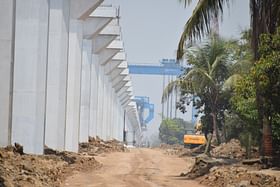NHSRCL has signed an agreement for the work related to the design and construction of the underground Mumbai high-speed rail station with MEIL-HCC joint venture.
This contract, awarded to Megha Engineering and Infrastructures Limited (MEIL) and Hindustan Construction Company (HCC) joint venture, is the first contract, worth Rs 3,681 crore for the total area of 4.85 hectares, being awarded on the Maharashtra side of Mumbai-Ahmedabad high-speed rail (HSR) corridor.
The total completion time envisaged in the contract is 54 months from the commencement date of the work, which means the work is expected to be completed by 2027-28.
The contract referred to as ‘C1 Package’ also includes cut and cover length of 467 m and ventilation shaft of 66 m. This shaft will also be used for taking out tunnel boring machines (retrieval shaft).
The station will have six platforms and length of each platform is approximately 415 m, which is sufficient to accommodate a 16-coach bullet train.
The station will have connectivity with the metro and road. Bandra Kurla Complex HSR station is the only underground station on Mumbai-Ahmedabad HSR corridor.
The platform is planned at a depth of about 24 m from the ground level. There will be three floors including platform, concourse and service floor.
Two entry/exit points are planned — one to facilitate the access to nearby metro station of metro line-2B and other towards the MTNL building.
The station has been planned in a way that ample space is available for passenger movement and amenities at the concourse and platform level. A dedicated skylight provision has been made for natural lighting.
The amenities planned for passengers at stations include security, ticketing, waiting areas, business class lounge, nursery, rest rooms, smoking rooms, information kiosks and incidental retail, public information and announcement system, CCTV surveillance, etc.
Besides that, the integration with other modes of transportation like metro, buses, autos and taxis is also planned.


